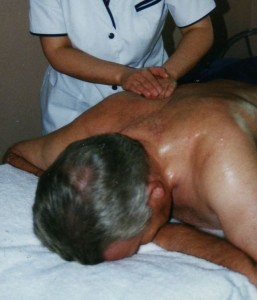Part four – Neuromuscular Technique and Soft Tissue Release
These two techniques work hand in hand to alleviate tension spots and pain with the aim of restoring movement. As with previous techniques discussed a lot of the effectiveness is due to the competency of the therapist to assess the tissues and select the correct technique for the current situation.
aim of restoring movement. As with previous techniques discussed a lot of the effectiveness is due to the competency of the therapist to assess the tissues and select the correct technique for the current situation.
This is one of the things I love most about massage in that it is constantly changing and therefore challenging. Even though I may have seen a client regularly over a long period of time I constantly allow my hands to feel the muscle tissue as things can and do change. It would be wrong to consistently offer the exact same treatment every time without assessing first.
Neuromuscular work is done on tight, knotted muscle where the pressure to these areas brings about a physiological change in the restricted tissue. It is commonly used on muscles that have been subjected to continuous tension such as the neck and shoulder muscles of those sat at desks for years. Some of these points will be the Myofascial Trigger Points (MTP’s) discussed earlier but others will simply be tension ‘knots’ with no referral pattern. The muscles come to recognise the extra tension as ‘normal’ because the muscle spindles adjust over time until a very tight muscle becomes recognised as ‘normal’. This is usually the point at which the area begins to show signs of inflammation and cause pain. Neuromuscular pressure can help release the tension and relieve the pain. It is believed this comes about due to ischemic changes in the tissues being compressed (*Hou et al, 2002).
Soft Tissue Release works to release tension in soft tissues – not surprisingly. By applying pressure to tension areas and then moving or stretching the tight muscle relaxation can result. It is a technique that can in certain circumstances be demonstrated by a therapist for a client to use at home. A study by **Hanten et al in 2000 found this type of home treatment with a therapist monitoring to be effective for the treatment of MTP’s.
“Ischemic compression therapy provides alternative treatments using either low pressure (pain threshold) and a long duration (90s) or high pressure (the average of pain threshold and pain tolerance) and short duration (30s) for immediate pain relief and MTrP sensitivity suppression”.
(**Hanten et al, 2002)
References
*Hou, C. R. Tsai, L. C. Cheng, K. F. Chung, K. C. Hong, C. Z. Immediate effects of various physical therapeutic modalities on cervical myofascial pain and trigger-point sensitivity.Archives Physical Medicine and Rehabilitation 2002 Oct:83(10): 1406-14
**Hanten, W. P. Olson S. L. Butts N. L. Nowicki A.L. Effectiveness of a home program of ischemic pressure followed by sustained stretch for treatment of myofascial trigger points. Physical Therapies 2000 Oct;80(10):997.1003